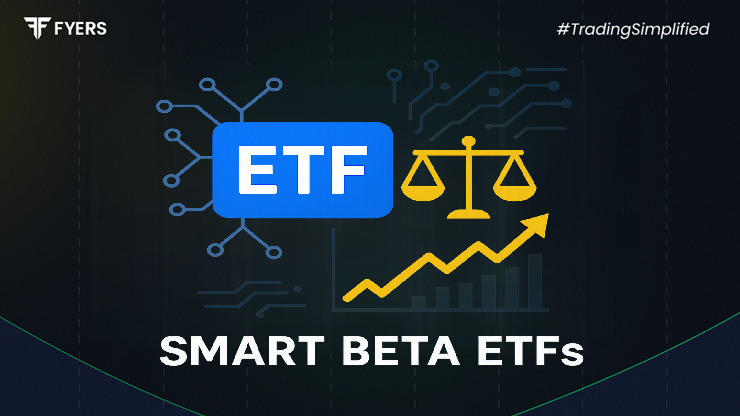

 23 Sep, 2025
23 Sep, 2025
 4 mins read
4 mins read

In the world of investing, the debate between active and passive strategies has been ongoing for decades. While passive funds aim to replicate the performance of a market index and active funds try to outperform it, Smart Beta ETFs sit somewhere in between. They combine the rules-based approach of index investing with the flexibility of active strategies.
This article breaks down what Smart Beta funds are, how they work, their benefits and risks, and why investors are increasingly adding them to their portfolios.
A Smart Beta Exchange-Traded Fund is an investment product that tracks an index but weights its holdings differently from traditional market-cap-based indices. Instead of only considering company size, Smart Beta funds use alternative factors such as:
Value (undervalued stocks)
Momentum (stocks with strong recent performance)
Quality (companies with stable earnings)
Low volatility (less risky stocks)
Dividend yield (companies with high payouts)
This approach blends passive investing with factor-based strategies, aiming to deliver better risk-adjusted returns.
A Smart Beta strategy builds a portfolio by following specific rules, but unlike a pure index fund, it doesn’t rely solely on market capitalisation.
For example:
A low volatility Smart Beta ETF might allocate more weight to stable companies with fewer price swings.
A value Smart Beta index fund could emphasise stocks that are undervalued compared to their fundamentals.
A multi-factor ETF may combine quality, momentum, and size to spread risk.
The goal is to reduce volatility, improve returns, or achieve both—depending on the chosen factor.
|
Feature |
Smart Beta ETFs |
Traditional Index Funds |
|---|---|---|
|
Weighting method |
Factor-based (value, quality, momentum, etc.) |
Market capitalisation |
|
Objective |
Enhance returns or lower risk |
Track overall market performance |
|
Cost |
Higher than passive index funds, but lower than active funds |
Lowest among all |
|
Transparency |
Rules-based, factors are predefined |
Fully transparent, market cap weighted |
|
Performance |
May outperform or underperform depending on market cycles |
Closely tracks benchmark |
In short, Smart Beta index funds give investors more control over risk and returns, but they come with higher complexity than traditional passive funds.
Diversification Beyond Market Cap – Provides exposure to factors often missed in plain index funds.
Lower Costs than Active Funds – More affordable than traditional active management.
Customisable Approach – Investors can choose factors aligned with their goals (e.g., income, stability, growth).
Potential for Outperformance – Some Smart Beta ETFs may beat the market in certain conditions.
Transparency – Rule-based strategy means investors know how portfolios are built.
Despite their appeal, Smart Beta funds are not without challenges:
Factor Cyclicality – Factors like value or momentum can underperform in certain market phases.
Higher Costs vs Passive Funds – Expense ratios are usually higher than plain index funds.
Complexity – Not all investors fully understand how factors interact.
Liquidity Issues – Some Smart Beta ETFs in India may have lower trading volumes.
Globally, Smart Beta has grown rapidly, with products covering equities, bonds, and commodities.
Global Examples: iShares Edge MSCI Min Vol USA ETF, Invesco S&P 500 Equal Weight ETF, and Vanguard Value ETF.
In India: Smart Beta ETFs are still relatively new. Options include:
Nippon India ETF Nifty Alpha Low Volatility 30
ICICI Prudential Nifty Low Vol 30 ETF
Motilal Oswal Nifty 200 Momentum 30 ETF
Investors can explore the Smart Beta ETF list on NSE or AMCs’ websites for updated offerings.
These funds may suit:
Long-term investors seeking better risk-adjusted returns.
Those who find pure index funds too plain but want lower costs than active funds.
Investors with specific goals such as stability (low volatility ETFs) or growth (momentum ETFs).
If you prefer simplicity, traditional index funds work fine. But if you want a factor-driven strategy, Smart Beta may add value.
Open a Demat and Trading Account – ETFs trade on NSE/BSE like stocks.
Choose the ETF – Based on your risk appetite and factor preference.
Check Liquidity – Ensure sufficient trading volume.
Invest Systematically – Some brokers allow SIP in ETFs, which can be applied here as well.
Review Regularly – Factors perform differently in different market cycles, so monitoring is essential.
Smart Beta ETFs bridge the gap between passive and active investing. By blending index-tracking with factor strategies, they offer diversification, cost efficiency, and the potential for outperformance. However, risks like factor cyclicality and higher costs compared to index funds should not be ignored.
For Indian investors, Smart Beta is still evolving but provides exciting opportunities to move beyond traditional index-based investing.
They are index-tracking ETFs that use alternative weighting strategies like value, momentum, or low volatility instead of just market cap.
While passive investing tracks an index exactly, Smart Beta applies factor-based rules to tilt the portfolio.
Not always. They may outperform in certain cycles but can also underperform. The choice depends on investor goals.
Yes. Examples include Nippon India ETF Nifty Alpha Low Volatility 30, ICICI Prudential Nifty Low Vol 30 ETF, and Motilal Oswal Nifty 200 Momentum 30 ETF.
Calculate your Net P&L after deducting all the charges like Tax, Brokerage, etc.
Find your required margin.
Calculate the average price you paid for a stock and determine your total cost.
Estimate your investment growth. Calculate potential returns on one-time investments.
Forecast your investment returns. Understand potential growth with regular contributions.